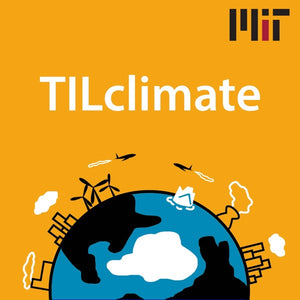
About
Climate change is confusing. This MIT podcast breaks down the science, technologies, and policies behind climate change, how it’s impacting us, and what our society can do about it. Each quick episode gives you the what, why, and how on climate change — from real scientists — to help us all make informed decisions for our future.
MIT Environmental Solutions Initiative
29 Episodes
Episodes
The Earth has gone through massive climate change before—many times over, in fact!—but human civilization has not. Prof. David McGee, a specialist in the study of ancient climates, joins the... more
The way we grow and distribute food today is deeply dependent on fossil fuels, yet that dependence can feel invisible. Sustainable food systems researcher Prof. Jennifer Clapp joins the show... more
The landmark Paris Agreement of 2015 gave the world a shared target for halting climate change: that global warming should stop well short of 2 degrees Celsius. But how did... more
The Earth naturally absorbs some of our climate pollution from burning fossil fuels. But how much, and how fast? Geophysicist Prof. Daniel Rothman joins the podcast to explain the nature... more
Today, companies are storing millions of tons of carbon dioxide underground every year to prevent this climate pollution from warming the planet. In the future it might be billions of... more
What if there was a way to continue using fossil fuels for energy without emitting CO2 into the atmosphere? To prepare for a new listener question about carbon capture, we're... more
Is hydrogen fuel a climate solution? That depends on how you produce it. Dr. Emre Gençer of the MIT Energy Initiative takes us on a tour of the hydrogen spectrum,... more
Just 20 years ago, hydrogen cars and battery electric cars were pretty evenly matched as clean alternatives to gas-powered vehicles. But today, batteries are way ahead: the big car companies... more
Hydrogen gas acts like a fossil fuel, but with no carbon emissions. Is it the silver bullet we’ve been waiting for? To prepare for some new listener questions about hydrogen... more
Wind power is the largest source of clean, renewable energy in the United States. But the large turbines that create that power can endanger wildlife. MIT Professor Michael Howland returns... more
You might have heard how wind turbines failed in Texas during a terrible cold front in 2021. Does this mean we can’t rely on this clean, renewable source of energy... more
Plants take in CO2 from the air to grow—and today’s atmosphere has about 50% more CO2 than it did before we started burning massive amounts of fossil fuels. So, is... more
The sixth season of Today I Learned: Climate is coming in two weeks, and this time we’re doing something a little different. People all around the world write into our... more
The United States has a goal to power the country with 100% clean electricity by 2035. Unfortunately, our energy regulations are not set up to make this much change this... more
Energy storage: keeping the lights on with a clean electric grid
The large majority of new energy we’re building today comes from clean, renewable wind and solar projects. But to keep building wind and solar at this pace, we need energy... more
We all want to live full, healthy lives. But climate change is threatening a growing number of people’s lives and well-being. Amruta Nori-Sarma, assistant professor of environmental health at Boston... more
TILclimate presents: What the heck is El Niño, anyway? (from Outside/In)
We were going to produce an episode on El Niño, and its relationship to climate change. And then we found out that Outside/In, from New Hampshire Public Radio, already did... more
If you live in the U.S. Mountain West, the Pacific Coast of the Americas, or large parts of Australia or southern Europe, there’s a good chance a major wildfire has... more
Today we’re talking about desalination: turning saltwater into freshwater, so we can drink it or use it to grow crops. And we’re talking about this because, in many parts of... more
Refrigerants are in every refrigerator, freezer and air conditioner, and the world is on track to make a lot more of them in the years to come. They’re also powerful... more
Carbon dioxide—CO2—is the greenhouse gas you’ve probably heard most about, on this podcast and elsewhere. But it turns out, methane is an incredibly important greenhouse gas too. Stopping methane emissions... more
You probably know that today’s climate change is caused by certain gases—what scientists call greenhouse gases—that human activity has been adding to our atmosphere. But—how do these gases actually keep... more
This is MIT’s climate change podcast, Today I Learned: Climate. If you're looking to get smart quick on climate change – without the jargon and without the politicking – this... more
On August 16, 2022, President Joe Biden signed into law the Inflation Reduction Act (IRA). It was the largest of three bills signed over the course of 10 months that... more
Announcing TILclimate's Live Event: "America’s big year of climate action"
On Wednesday, April 19, TILclimate will host its first live event at the MIT Museum in Cambridge, Massachusetts! Reserve your seat at tilclimate.org to watch a live recording and join... more
We often hear about recycling as a way to make an impact on climate change right in your own home. But how big a difference are we really making when... more
Winters are warming faster than any other season here in the U.S. So why are some winter storms getting even more intense? Today, we’re going to explore the connections between... more
What if you could pay someone else to cancel out your carbon emissions? As countries, organizations, and even individuals around the world commit to lowering their impact on the climate,... more
Roughly ten percent of the world’s CO2 emissions come from passenger vehicles: cars, pickups, motorcycles, buses, and taxis. So today, we’re going to zoom in on how people get around... more




